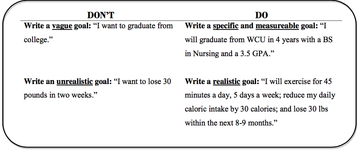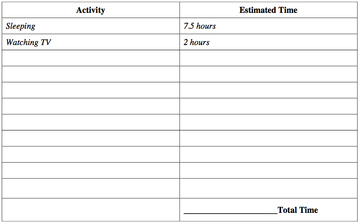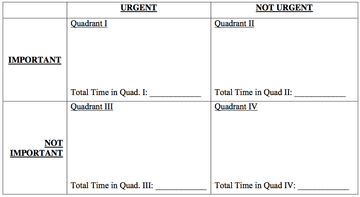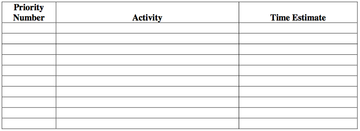Establish your goals
If you want to use your time more productively, first you must identify what you hope to accomplish. Once you’ve established your goals, identify the activities necessary to each goal and schedule time to carry out each activity.
Goals should be specific, measureable, and realistic. The following examples illustrate the differences between well-defined goals and vague, immeasurable, and unrealistic goals:
Exercise 1: Write one specific, measurable, and realistic long-term goal for yourself—Long- term goals typically require a year or more to accomplish. Your long-term goal may be academic in nature, or it may be related to your family (e.g. “I want to improve my relationship with my brother”), your lifestyle (e.g. “I want to find a roommate with whom I’m compatible”), your finances, or your future career. Here’s an example of a long-term financial goal: I want to save $1500.00 over the next year so that I can go on a 7-day cruise to the Caribbean when I graduate.
Exercise 2: Now write one related, short-term goal that will act as a “stepping stone” to your long- term goal—Again, be sure that your goal is realistic, specific, and measurable. Short-term goals typically require less than a year to accomplish.
An example of a short-term goal related to the long-term financial goal: Tomorrow I will interview for an on-campus job that will allow me to work 20 hours a week.
Exercise 3: Analyze how your time is spent—Make a list of every activity you have been involved in since this time yesterday. For each activity you list, estimate the amount of time you spent in that activity. When you add up your estimated times, you should have close to 24 hours. Two examples are provided below to get you started.
Exercise 4: Did your activities during the past 24 hours contribute to the goals you established for yourself in Exercises 1 & 2? If not, could you have substituted any of the activities above for different activities that would have contributed to your goals? If you had prioritized the activities so that you were able to focus your energy on the activities that were important to your goals, which activities might you have left out? List them here:
Prioritize Your Activities
Prioritizing is a necessary skill for effective time management. The Quadrant Graph below, adapted from Stephen Covey’s Seven Habits of Highly Effective People (1989), is a time management tool that you can use to prioritize your activities. Each square, or quadrant, represents a different type of activity.
Quadrant 1 represents tasks that are important and urgent. Example: Staying up late to study for a test you have tomorrow morning.
Quadrant 2 represents tasks that are important but not urgent. Example: Spending two hours in the library working on a paper or project that is not due until the end of the semester.
Quadrant 3 represents tasks that are not important but are urgent. Example: Agreeing at the last minute to go to a movie with friends. Note: Quadrant 3 activities are usually unplanned or spontaneous.
Quadrant 4 represents tasks that are not important and not urgent. Example: Watching five hours worth of TV shows in which you are only mildly interested.
Exercise 5: Refer to the list of activities you compiled in exercise 3 above. Enter each activity and the corresponding amount of time in the appropriate quadrants on the graph below. Using the estimates of time you wrote for each activity, add the total time spent in each quadrant.
Exercise 6: Where did your time go? In which Quadrant was the majority of your time spent during the past 24 hours? If you were to manage your time in a way that would allow you to achieve your goals, in which of the four Quadrants would you spend the majority of your time? Why?
A. The majority of my time was spend in quadrants________.
B. In order to achieve all of my goals, I should spend the majority of my time in quadrants______.
C. Why should the majority of my time be spent in these quadrants?
Exercise 7: Create a list of 5 to 10 activities you need to complete within the next week. Estimate the amount of time it will take you to complete each activity in the right-hand column. Once your list is complete, prioritize the list by numbering each activity from 1 to 10 (1= highest priority and 10= lowest). Activities that are both important and urgent will be assigned high priority, while activities that are neither important nor urgent will be assigned low priority.
Schedule Time to Complete Your Activities
Once you’ve identified your priorities, it is important to allocate time to complete each activity. Some people prefer to keep a written calendar on which they schedule time to complete certain tasks; others prefer to keep an electronic calendar; and still others prefer to enter reminders about important activities in their cell phones. It is important that you design a scheduling/calendar system that works for you. If you know that most of your time is spent away from your computer, you can assume that an electronic calendar probably won’t work.
Exercise 8: In the space below, describe one strategy you could use to keep track of the priorities on your list above. Explain why this particular strategy will work well for you.





Congratulations @oconnor164! You have completed some achievement on Steemit and have been rewarded with new badge(s) :
Click on any badge to view your own Board of Honor on SteemitBoard.
For more information about SteemitBoard, click here
If you no longer want to receive notifications, reply to this comment with the word
STOPDownvoting a post can decrease pending rewards and make it less visible. Common reasons:
Submit
Congratulations @oconnor164! You have received a personal award!
Click on the badge to view your Board of Honor.
Downvoting a post can decrease pending rewards and make it less visible. Common reasons:
Submit
Congratulations @oconnor164! You received a personal award!
You can view your badges on your Steem Board and compare to others on the Steem Ranking
Vote for @Steemitboard as a witness to get one more award and increased upvotes!
Downvoting a post can decrease pending rewards and make it less visible. Common reasons:
Submit